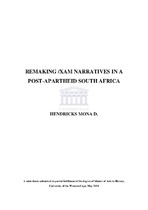| dc.description.abstract | Public history has become a dynamic new field of study in South African historiography during the post-apartheid period. As a field of applied history, it has been engaged with analysing the highly contested nature of knowledge production across a wide range of public sites. These include museums, art galleries, archaeological digs, theme-parks, shopping malls, tourist attractions and heritage sites. The wider national cultural and political challenge has been that of working towards restoration, healing, and reparation in the wake of a colonial and apartheid history marked by particularly acute brutality and dispossession. This thesis analyses the attempts of one public institution, the Iziko South African Museum, to negotiate the remaking of public history in the post-apartheid period. Unlike some of the newer sites of cultural production, such as the Cape Town Waterfront and the West Coast cultural village of !Kwa-ttu, the South African Museum has a century-long history of complicity in generating images of racial and cultural others, notably Khoisan communities. The thesis begins by exploring this history and the ways in which the South African Museum has tried to come to terms with this legacy in its post-apartheid policies: firstly, in the discussions and debates around the closing of the Bushman diorama (2001), and secondly, in the creation of a new exhibition on San rock art which draws extensively on the Bleek-Lloyd Collection (/Qe: The Power of Rock Art. Ancestors, Rain-making and Healing, 2003 to the present). The Iziko South African Museum has not been successful in its attempts to meet the challenge of coming to terms with its history of collecting human remains and creating body casts and putting them on display. I argue that the measures it has introduced over the last twenty two years, including the ‘revision of the Bushman diorama exhibition’ (1988-89), to Miscast (1996), and the closure of the diorama (2001), are little more than window-dressing and staged productions, with lip-service being paid to transformation. In the place of the effective opening out of debate and discussion about the Museum’s history of racial scientific research, we have seen the presentation of a new framework of knowledge about Khoisan communities through the ‘lens of rock art research’ and the Bleek-Lloyd-/Xam records. I see these as a way of sanitising the story about colonialism and apartheid. In making these arguments I draw upon a number of scholarly works by academics involved in public and visual history; recent literature on trauma narratives; Foucauldian discourse; and newspaper. | |

